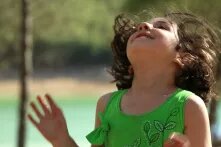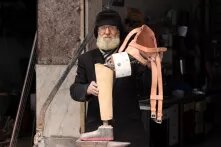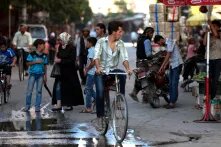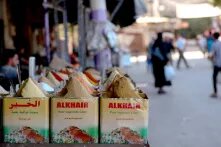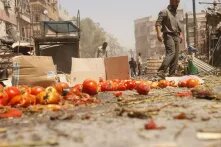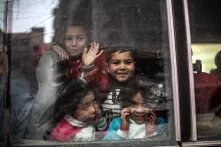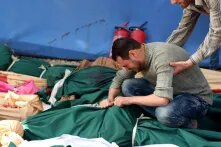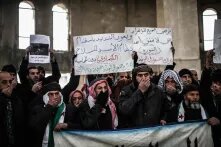
Introduction
I started my beautiful endeavor with this book when I offered my friend Nadine Elali to edit the texts Tim had written captioning his photos and the stories of people he captured in them.
I am attached to my people - the active ones - and I always follow my passion to collaborate with them on projects, particularly when the project partner takes a different approach in dealing with our issues…
“The image:” Tim’s eye captures the tragedy in death and talks of much beauty thereon. It tells the story of people and its utmost concern is to be faithful to what it sees. It documents their stories and arranges them chronologically, marking each event, as if opening a history book and highlighting the most important or memorable parts.
But Tim is not a writer, and his concern was to bring his image to light in the way he wanted to, and so the texts he wrote were more of a descriptive nature and did not do the image justice. I asked him to turn it into a literal narration that would complement the image in value without compromising the simplicity of the texts nor modifying the facts contained therein. And this book came to be.
HANI AL SAWAH
Preface
I was 18 years old when the uprising began in Syria. Today, I am 25 years old, and throughout the past 7-8 years, I have done nothing but document.
After the first chemical attack on Ghouta in 2013, I became aware that the regime was trying to change the narrative about what is happening in Syria. So, I began building my photo archive documenting what life looked like under siege in order to ensure that the regime would not jeopardize the truth and rewrite history on its own terms.
I did not go to school and study photography, everything I know is self-taught. I developed my techniques on my own, and my photos are a work of experience. I believe that the photo speaks volumes and consider it a means to argue the truth and the last defense we have against all the fake news the regime is generating.
I had my life on pause until this book. I felt responsible towards everyone living here in Syria, and so I thought this is the needed opportunity to make their stories heard. I felt hopeful and content to see at this moment that the past years of my life have not gone to waste and that I was able to contribute to some form of change.
The media covers mainly one side of the story, the part that is made out of military strikes, numbers of people killed, numbers of refugees, and the attention with which it is rewarding negotiations pretending they would not be determined to fail. Little do they cover people’s day to day stories that have no choice but to be in this situation. In this book, I delve into the personal reality that exists between the lines, what media has failed to capture.
I tells stories from both Ghouta and Idlib. I was forced to leave Ghouta in the first half of 2018. Now I am in Idlib documenting life as it unfolds. We live in great fear that Idlib will be facing the same fate as Ghouta.
It is crucial therefore to show that there are civilians living here, millions of them, who have experienced so much tragedy and yet they still carry on with their lives. It is vital for them to get support and not be labeled as terrorists and extremists merely for having opposed Bashar al-Assad and his rule.
The photos I captured looked nice aesthetically but their backstories were sad, and so I found excruciating tension between what I saw at first glance and what I learned when understanding the stories. The families I met, had at least one member who was either detained, missing or been killed. It would remind me of my father as he too is missing still. There was so much heartache as I came face to face with myself. I was overwhelmed by the beauty of the images and the unknowing of what was going to happen, whether to me or the people I met.
I am not that much looking for sympathy for all the suffering we have gone through and continue to do so, but on the contrary, I want to show how strong my people are. All we need is some stability, freedom, and the needed resources and we will choose life over and over again.
Foreword
Civilians are, and remain to be, the overwhelming majority in a country experiencing conflict. For the Syrian province of Idlib, Syria’s last rebel-held province, the United Nations established the number of civilians to be “more than 99%.” However, only armed groups and actors make the news headlines. This has contributed to an international perception that “there are no good people left” in Syria.
This fails the far more complex reality. Instead of belittling, or even denying the relevance of civilians, we should talk more about them and acknowledge what they are doing in ever more difficult circumstances.
The photojournalist, Tim Alsiofi, was only 18 years old when the revolution began in Syria. The Syrians regime did not take it up for what it really was - as a political uprising of those excluded from having a say - but instead responded to it as security challenge to be subdued by any means.
The essential threat activists and journalists faced early on by the regime happened to be matched by another among the extremists on the opposition side, entirely in line with a dictatorial approach to citizens: bombing and torturing independent minds into submission in order to suffocate citizen-oriented activism.
In his hometown in besieged Ghouta, Tim spent the first years of his adult life do
cumenting death and destruction before boarding one of the infamous “green buses” of deportation to Idlib. Upon his arrival there, we asked him to show us life in that province. We did not know what to expect, but the first 153 photos Tim sent were breath-taking. So much colour, so much life we had not seen in a long time from inside Syria. Yet we were aware of the fact that these images, if not put into context, might feed into the misled debate on “return” in allegedly “safe” areas, when the more urgent question – absent from Western political debates – is how to find a way to help those trapped inside Syria, or if this could not be achieved: allow them out.
The deeper we dug with Tim into the stories of joy coupled with the losses, of hopes nipped in the bud yet re-emerging, the more we were convinced that this way, of not only sharing impressions but displaying the sweet and sour broader context of the reality behind these photos, really matters. For that, we paired Tim with Syrian writer and rapper Hani Al Sawah whose words helped create a personal narrative telling the story. The collaborative work speaks volumes about civilians doing what any civilian should be doing - living. Buying and selling. Diving into the unknown. Fishing. Barbecuing. Celebrating weddings and public holidays. Or for children: learning at school or simply spending time at a playground.
The Syrian regime keeps insisting it wants to take back “every single inch of Syria.” Whether or not it will, in the end, embark on a military offensive against Idlib is at the time of this writing, not predictable. However, “freezing” the situation is not realistic for civilians in Idlib because of international aid trickling down – a situation that is prone to exacerbate civilian suffering in an area which hosts on top of its inhabitants more than one million internally displaced. So the question of how to help and support them remains imminent.
All those men, women and children portrayed in this volume do not live their life as if there was no tomorrow. On the contrary: They act as if today was only the beginning of a brighter future. We can't but admire their strength and resilience, and we perceive it as our duty carrying out their words and these rare insights into the world.
This book is a monument to all women and men who defy this nihilist equation of “either with or against us” by their strong belief in a better future and all their efforts to make it happen. It is a reminder that life will always prevail over death.
DR. BENTE SCHELLER, NADINE ELALI AND ROUA ARAKJI
Slide the gallery











